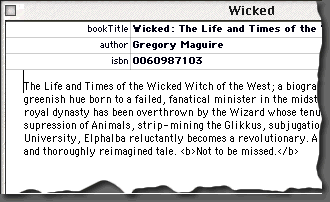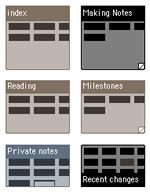|
construction workers (3 Nov 2001 )
We usually think of Tinderbox agents as doing the hard work of organizing and sorting notes for an established, ongoing project, but they're often handy assistants when planning and building a new collection. For example, I was recently fleshing out the skeleton of a paper in Tinderbox. I'd made notes to represent topics I wanted to cover, and spent a few hours deciding which topics needed to come first, which were vital, and which might be expendable. I was on deadline, worried that the paper would exceed the publication's word count, and also anxious to allocate my time wisely, spending what time I had on the tasks that most needed to be done.
A big help was a temporary agent only for constuction scaffolding. It simply looked for notes which contained little or no text, and colored them red; notes that needed to be written from scratch literally lept out from the page. The agent took seconds to write, and made meeting the deadline much less unpleasant than it might otherwise have been.
Continuous Text (19 Oct 2001 )
In Tinderbox, we usually have lots of windows open at once. We have maps for keeping track of dozens, even thousands, of interlinked notes.
Sometimes we thread those notes together. For example, the page you're reading is assembled from about a dozen separate notes. The Tinderbox Peekhole site is generated from a Tinderbox file; it contains about 110 notes, which are sent to a bunch of pages.
At other times, we might want to see a selection of notes assembled in one sequence. A new, experimental Tinderbox view does exactly that: it shows the texts from a collection of notes (or a path of interlinked notes) in a continuous scroll. If you reorganize that sequence, the change appears immediately in the text window.
Eric Cohen's suggested this many times over the years. But since a Japanese research group led by Kumiyo Nakakoji was the first to actually implement a hypertext view like this, we call it the Nakakoji View.
what is "today"? (21 Sep 2001 )
Date formats need to be flexible because readers and writers vary greatly in their preferences. For some, today's Web page needs to be titled "søndag, 16 september 2001". Others want 9/16/01. Syndication files need RFC-822 standard dates. Tinderbox now lets you use your system's local dates or customize dates to fit the situation.
Faceted classification (24 Sep 2001 )
Peter Merholz argues that the key to combining innovation and organization in information architecture is faceted classification. Instead of beginning from big, fixed, inflexible hierarchy into which we must pour ever-changing content, Merholz suggests we begin with the objects, adding facets (attributes and values) until the most useful classifications emerge. As the information grows and changes, the classification changes organically.
Tinderbox quick stamps make it easy to classify items (which is important, because there's never enough time to add metadata). Tinderbox agents can mark facets automatically (which is important, because people forget to put TITLE tags on their pages, much less complex metadata. And Tinderbox templates make it easy for you to use metadata to make fast, visible, productive changes to your site structure.
Taxonomy Software (16 Oct 2001 )
OJR takes a look at Taxonomy Software -- tools that automatically categorize notes, either through collaboarative filtering or by recognizing patterns. Paola DiMaio concludes that "Taxonomy software is likely to be expensive, as initially it will be targetted at corporate enterprises. But as many portals and corporate intranet producs begin incorporating a default element of content categorization, more entry-level "personal" categorization tools will be available. Sounds like Tinderbox, doesn't it?
personal content management (6 Sep 2001 )
Tinderbox is a personal content management assistant. It helps you gather ideas and notes. It helps you organize and understand them. And it helps you share them.
The personal aspect of Tinderbox is very important. It doesn't organize ideas for the enterprise; they've got to be your ideas, first. It doesn't scoop up content and repackage it; it helps you say that you want to say. Your data is yours, and it's always right there with you; no delays, no downtime. And since Tinderbox files are XML, you don't need to worry about getting at your own ideas.
Prototypes (7 Jul 2001 )
Tinderbox notes can have prototypes that help shape their contents and presentation. For example, my personal site,
MarkBernstein.org, contains a section of book notes. Each book's entry is a separate Tinderbox note. All the notes about books have the same prototype, which tells Tinderbox that "author" and "ISBN number" are key attributes of books and ought to be displayed prominently.

The book prototype also remembers where the HTML template for books is kept, marks all books with the same color so they're easy to find in Map views, and takes care of other little housekeeping chores. Other kinds of notes, like news notes, schedule notes, and software notes have different prototypes. When something changes, I don't need to change every book individually; changing the prototype changes each of the books as well.
Hue and Value (30 Jun 2001 )

Hypertexts are complex. That's why we need maps. But maps are themselves complex; drawing a picture of a complex system helps us understand, but the ideas and connections don't become simple just because we drew a picture. Helping people see all the information we can express is a real challenge.
One thing that might help is paying closer attention to elements of graphic design. Eastgate's Eric Cohen has been arguing for sparer, cleaner maps for years -- maps where we'd have solid blocks of color instead of outlines. Another important step is using color more carefully and intelligently. People are good at judging
small changes in hue and lightness (what artists call 'value'); instead of the traditional bright colors of Storyspace maps, we might benefit from using a wider array of colors chosen from a more compact palette. We're trying to make this easy; in Tinderbox, for example, you can pick a color that's "just like that one, only a little lighter".
We're also working on good ways to let people think about color logically. An agent might set all private items to be "cool gray", for example. The definition of "cool gray" is up to you; you might change it next year when the new fashion colors are out or when your new LCD panel arrives. Computer scientists call this "another layer of indirection."
Link Types (29 Jun 2001 )
We've quietly added link types to the next Tinderbox release. Typed links are an interesting idea; the should make documents more expressive. At minimum, the should make it easier to remember and explain why two notes are linked together. The problem has always been
getting the link types right. We're looking at ways of letting people customize and share sets of link types in the same way graphics programs share color palettes.
|